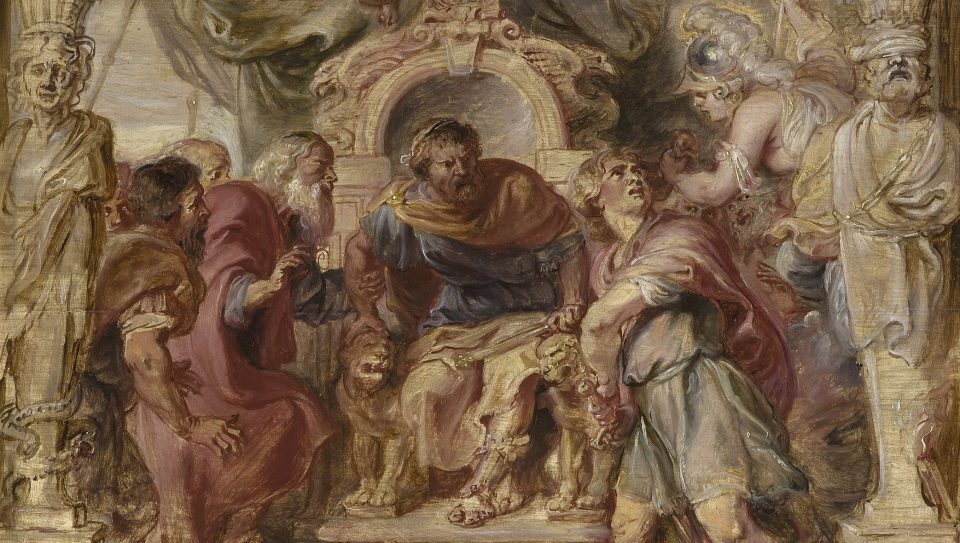
Homer’s The Iliad, which recounts the fabled story of the Trojan War, is perhaps the most famous of ancient Greek literary works. Its subject matter is rousing and electrifying yet also profoundly human. It is a tale of war and conflict but also of love and loss. With themes so central to the universal human experience, it is no wonder that Homer’s epic is still being referenced to this day.
In fact, scenes from Homer’s epics have passed through the gifted hands of many famous artists, whether of sculptors or painters. Below are some of the most famous artworks that skillfully depict scenes from The Iliad.
The Most Famous Artworks Depicting Scenes from Homer’s Iliad
The Euphronios Krater

The Euphronios Krater is, as its name suggests, a crater, a type of vase used in antiquity to mix wine with water. This crater was the work of Euphronios, a vase painter and potter who lived in Athens during the 6th to 5th century BC. He is an important artist from antiquity who worked with the red-figure technique in his vases.
In the Euphronios Krater, the artist captures two scenes from Greek mythology. The one at its front comes from the Trojan War. It illustrates the death of Sarpedon, a young son of Zeus who fought valiantly on the side of Troy and met an untimely end. In a moment of sorrow, the gods Hypnos (Sleep) and Thanatos (Death) carry his lifeless body, while Hermes, the messenger of the gods, observes the procession.
This artwork is a powerful example of how ancient Greek artists, even nearly two centuries after the publication of The Iliad, were inspired by Homer’s work in their art. It is a testament to the deep influence of Homer’s epic poem. Today, it can be found in the National Archaeological Museum of Cerveteri in Italy.
Achilles and Briseis (or, Briseis taken away from Achilles)

Achilles and Briseis is a fresco which again emphasizes the thorough magnitude of Homer’s work. It was discovered in Pompeii in the House of the Tragic Poet and dates from the first century AD.
This Roman fresco, painted in bold, vibrant colors, portrays that scene at the opening of The Iliad in which the Trojan captive Briseis is ushered away from Achilles by Agamemnon’s men. Briseis had originally been awarded to Achilles as a prize of war. However, after Agamemnon (the Mycenaean king and commander) had to return his own captive, Chryseis, to appease Apollo, he demanded Briseis instead.
One can clearly make out the chiseled figure of Achilles, sitting on a chair holding his spear with an affronted expression on his face. Beside him with his back to the viewer is Patroclus, who is seen handing a shrouded Briseis over to Agamemnon’s men. The significance of this artwork is that it pictures a defining point in The Iliad—the beginning of the wrath of Achilles.
Andromache Mourning Hector, by Jacques-Louis David

Jacques-Louis David was a French neoclassical painter known for his portrayals of scenes from the ancient Greek and Roman periods. From his works inspired by The Iliad and its characters, the most renowned by far is Andromache Mourning Hector, painted in 1783.
As its name suggests, it shows the Trojan princess Andromache grieving for her husband Hector, killed by Achilles. All light falls on the striking expression of grief in Andromache’s face. The painting also shows her son with Hector, Astyanax, attempting to comfort her, but her gaze remains upwards, blinded by her loss.
The muted, subdued hues of David’s painting combined with the strong feelings it provokes on the viewer render it one of the most masterful executions of the scene of Hector’s death in The Iliad.
The Life of Achilles, by Peter Paul Rubens

The Life of Achilles isn’t a single artwork but a series of tapestries crafted by Peter Paul Rubens showcasing eight defining scenes from the course of Achilles’ life. These allow a comprehensive glimpse into the life of the glorious hero.
Rubens begins from Achilles’ childhood, painting the scene during which his mother Thetis dipped him into the river Styx to grant him immortality. As in The Iliad, Thetis holds her son from his right heel, the spot that ultimately became his demise. This series of tapestries continues with Achilles’ education by the centaur Chiron, while Rubens also portrays some key scenes from Homer’s epic, including Briseis Restored to Achilles and The Death of Hector. All are painted in Rubens’ characteristic Renaissance-Baroque style with lively colors and vivid emotion.
The last tapestry in Rubens’ series visualizes perhaps the strongest scene in The Iliad emotionally—the death of Achilles. Charged with feeling, it shows Achilles succumbing to his death, while what goes on around him could be described as “gentle chaos.” As such, this tribute to Achilles from an artist such as Rubens, as well as from all other artists across the globe, amplifies the status of The Iliad as a work that knows no boundaries, spatial or temporal.
